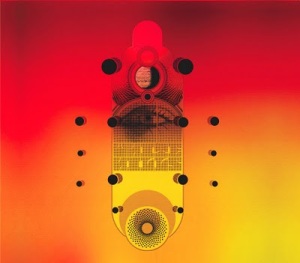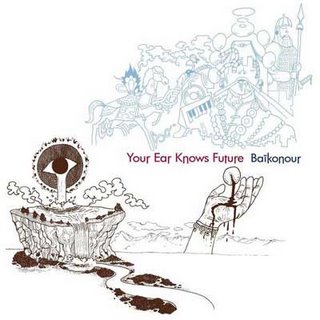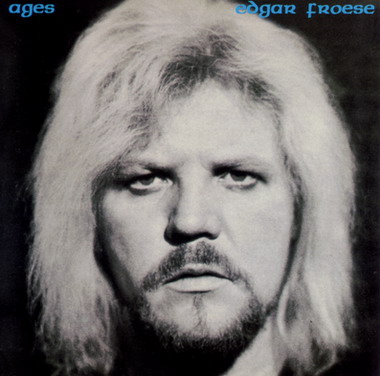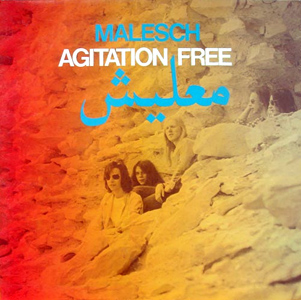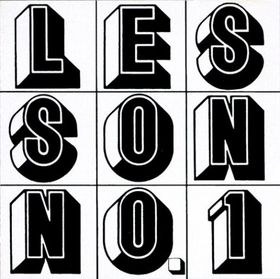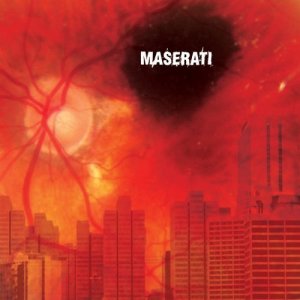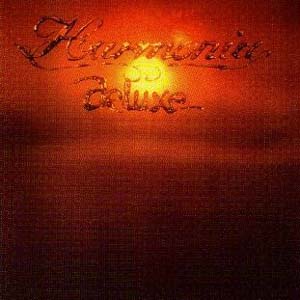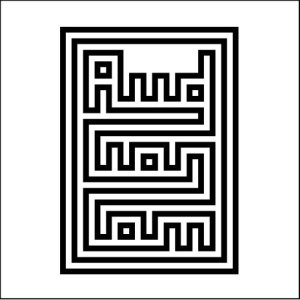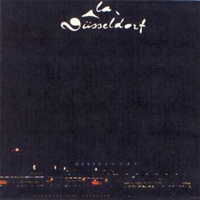Info: “Ah, Space Rock. As one of the tracks on this very fine album suggests, don’t be afraid, and don’t panic either! If you think this much-maligned genre reeks of stale patchouli, un-washed hair and trips to free festivals to see Ozric Tentacles whilst gorging on mushroom sarnies and cider then you’re missing the point. Early Lemmy-era Hawkwind was radical street fighting punk rock! The heads-down motorik fuzzed-out elements of Amon Duul II and Can were a huge kosmiche fuck you to the safe early 70s singer-songwriter status quo. Marry all of this to a righteous fist in the air stoner-punk spirit and you have the essence of what we’re dealing with here. (Drowned in Sound)
White Hills – White Hills (2010)
March 11, 2010Wooden Shjips – Dos (2009)
August 12, 2009Info: San Francisco’s enigmatically named Wooden Shjips play a minimal, droning brand of garage-styled psychedelia with a noticeable ’60s Krautrock influence. The band’s vocals slip beneath waves of throbbing minimal rhythms, while fuzz tone guitar and shrieking organs jump to the foreground. The idea was that untrained players would have a brand new outlook on music and could bring something fresh to the table, perhaps a blend of the often noisy trance rock of the Velvet Underground and the frenetic mania of the one-hit wonder garage punks of the early ’60s. Bassman Dusty Jermier, for example, was originally recruited to play sax, an instrument he’d never picked up before. Other members from that first incarnation often had such a lack of interest in playing live, the band hardly bothered looking for gigs.
Baikonour – Your Ear Knows Future (2009)
April 16, 2009Info: Baïkonour is the brainchild of one man, Jean-Emmanuel Krieger. Named after a town in Khazakstan, Krieger’s project combines electronic and post-rock elements with a deep appreciation for the versatility of the guitar. Krieger, who hails from France, currently resides in Brighton. His roots, however, have inevitably led to comparisons with groups like Air and Super Discount. Krieger draws on a variety of inspirations, which manifest themselves in his music in different ways. These inspirations include a diverse group, ranging from Marvin Gaye to My Bloody Valentine to Alice Coltrane. Upon the release of his debut album, For The Lonely Hearts of the Cosmos, in 2005, Baïkonour received positive reviews from critics. Matthew Murphy, a writer for Pitchfork Media, said of the Lonely Hearts, “Throughout the album, Krieger consistently astonishes with the daring breadth of his playing, as he embellishes several otherwise straightforward pop hooks with as much florid ornamentation as good taste will allow… And this he does with such an addictively melodic flair that it should be easy for listeners to find space for this album within their lonely hearts.” (indiepassion)
Edgar Froese – Ages (1977)
March 4, 2009Info: Edgar Froese is a great musician and a shrewd businessman. Realizing that he and his associates would need money to fund the progress of Tangerine Dream, he took advantage of both of those qualities and launched his solo career while Tangerine Dream was still in their infancy. That solo career has contributed many gems and classics to the e-music community. Ages is one of those classics. This album has all of Froese’s virtuosity and something that his listeners rarely hear — a sense of humor. Froese does not show that side of himself to his listeners very often, so it is a treat. Putting that positive energy into play does much for this album; it makes it a classic. This CD will appeal to fans of Paul Ellis, Ian Boddy, Ron Boots, and Mark Dwane. It is an e-music essential. (allmusic)
Agitation Free – Malesch (1972)
January 7, 2009Info: The debut album by Agitation Free followed a somewhat different path than your average Krautrock band, veering unexpectedly toward the Middle East, specifically Egypt, in search of atmosphere and material. Underneath the dueling guitars and spacy synth work, desert rhythms and taped sounds of dusky cities percolate, adding depth and spice to the otherwise smooth, Teutonic grooves. It’s a tribute to the apparent sincerity of the band that the use of these motifs does not sound at all contrived, instead integrating quite well. The delicate, intricate percussion that concludes “Ala Tul,” for instance, sounds as lively as anything by Steve Reich from around the same period. Tapes of street songs emerge surprisingly and effectively toward the end of the otherwise stately march “Khan El Khalili,” providing a bridge to the Terry Riley-ish organ trills that begin the title track. “Malesch,” like many of the tracks, spins off into a leisurely stroll, sounding unexpectedly close to some Grateful Dead jams. Even when it picks up pace, there’s an unhurried quality that fits in nicely with the Saharan undertones of the album. Malesch is a solid, even inspired recording that stands somewhat apart from the usual clichés of the genre. Fans of German progressive rock from this period will certainly want to hear and enjoy it. (review by allmusic)
Glenn Branca – Lesson No. 1 (1980)
November 17, 2008Info: Lesson No. 1 was Branca’s first release in which he delved more fully into instrumental sounds that melded the dissonant rock of his former outfits with the heavy, massed sounds that he would later explore with groups of anywhere between ten and a hundred guitarists. Originally issued on 99 Records in 12” format, Lesson No. 1 contained two songs, one on each side.
This cd reissue contains those tracks, “Lesson No. 1 for Electric Guitar” and “Dissonance,” as well as “Bad Smells,” a dance score previously available on a split LP with poet John Giorno. In “Lesson No. 1…,” Branca first exhibits the formula that would serve as the basis of his next LP, The Ascension, a combination of heavy, repetitive, rhythmic statements overlaid with a chorus of guitars that begins in an almost stately mode before rising into a celestial frenzy.
The more aggressive “Dissonance” also builds on a straightforward, repetitive rhythm, though the clangy interjections from the guitars and percussion, and the mechanical yet furious strumming that follows take the track in a new direction in which the different parts of the piece hurtle along together like a locomotive, then battle in and out of rhythmic phase with one another. The twitching rhythms suggest Was (Not Was) and James Blood Ulmer, but the five guitarists, including Sonic Youth’s Thurston Moore and Lee Ranaldo, revel in the darker side of the naked city, sinister and slashing. (dustedmagazine review)
Klaus Schulze – Picture Music (1975)
September 26, 2008Info: Klaus Schulze had always wanted to compose “Picture Music”: Sounds like oil on a private canvas, journeys into foreign, emotional landscapes. Which is why you can consider the title of this record as a credo, which made its appearance during a period of change.
While the two debut albums (“Irrlicht” and “Cyborg”) were mostly made up of static layers of noise and seemed to stem from a crass avantgarde mentality, the drummer in Schulze slowly found his way back into the music with “Black Dance” and “Picture Music”. This becomes clearest on Side B of the original record, the 23-minute long “Mental Door”. While synthesizers take bizarre twists and turns to form melody-like structures, a clanking percussion track decidedly cleaves its way through empty space. In its radical approach, this piece is still unrivaled today und should appeal to all those who find even the most daring and eccentric ELP-keyboard solo too radio-friendly. Still, the first composition here, “Totem”, is even better: A threedimensional musical vision full of truth and madness. A fragile pattern of bell-tones is the rhythmical pulse, which guides the listener through swathes of harmonic fog and constantly evolving motifs
Amon Düül II – Yeti (1970)
August 14, 2008Info: The second album by Amon Düül II (not to be confused with the more anarchic radicals Amon Düül), 1970’s Yeti, is their first masterpiece, one of the defining early albums of Krautrock. A double album on vinyl, Yeti consists of a set of structured songs and a second disc of improvisations. It’s testament to the group’s fluidity and improvisational grace that the two albums don’t actually sound that different from each other, and that the improvisational disc may actually be even better than the composed disc. The first disc opens with “Soap Shop Rock,” a 12-minute suite that recalls King Crimson’s early work in the way it switches easily between lyrical, contemplative passages and a more violent, charging sound, and continues through a series of six more songs in the two- to six-minute range, from the ominous, threatening “Archangels Thunderbird” (featuring a great doomy vocal by mono-named female singer Renate) to the delicate, almost folky acoustic tune “Cerberus.” The improvisational disc contains only three tracks, closing with a nine-minute stunner called “Sandoz in the Rain” that’s considered by many to be the birth of the entire space rock subgenre. A delicate, almost ambient wash of sound featuring delicately strummed phased acoustic guitars and a meandering flute, it’s possibly the high point of Amon Düül II’s entire career.
Michael Rother – Flammende Herzen (1976)
August 2, 2008Info: In his solo career Michael Rother exactly reproduced the most meditative and floating textures of Neu! music. His colleague Klaus Dinger launched L.A Düsseldorf for radical, abrasive pop electronic projections. “Flammende Herzen” directly announces Rother typical guitar instrumentation with all these elegant repetitions and evocative, almost romantic ambient melodies. This album is a collection of various slow moving guitar inventions. The title track introduces a nostalgic and mellow theme for guitar. After 3 minutes the main melody is took back in a much more punchy instrumentation, featuring almost metronomic drum parts and distortion; a very pleasant and accessible song. “Zyklodrom” contains a rather similar introspect and light repetitive melody but includes some synth arrangements. “Karussel” is an other floating track, featuring a mechanical pulse some very light keyboard sounds with a pop, simple melodic line. The less consistent song of the album. “Feuerland” is a dense, dramatic, moody composition with slide fuzzy guitars, hypnotic pulses. The last piece is made of electronic gadgets, rolling drums and tranquil synthetic ambiences. A colourful album and a good start to Michael Rother’s intimate work. (http://www.progarchives.com)
Eroc – Eroc (1975)
June 3, 2008Info: Eroc (Joachim Heinz Ehrig) started his solo career in 1975 while he was currently the drummer of Grobschnitt. His self titled album can be considered as a cross between Gorbschnitt’s typical symphonic amazing music and electronic/ synthscapes dominated by numerous original sound manipulations. Despite that he was originally recognised as a drummer, here Eroc is the man behind the machines, controlling solid essays in synth experimentations and electronic collages. His first album is an absolute must in Kraut/ electronic genre, very abstract, emotional and a mix of different moods. This album is an opponent worthy of Klaus Schulze’s first realisations in space/ “kosmische” electronic music. His following album (“Zwei” published by “Brain” in 1976) continues to process by a combination between rock and electronic but focused on short, efficient sketches. Humour and derision are clearly exposed in the lyrics and recitations. “Zwei” is a reminiscence of Grobschnitt’s theatrical universe with lot of “gags” but the atmosphere is much more introspective, sometimes delivering deliciously melancholic melodies. After this two first very recommended efforts, Eroc pursues his solo career notably providing a kind of reunion, family album (“Eroc 3”) with others Grobschnitt members. In parallel he also started a professional career as musical producer, recently published albums of Das Scheitas (among others).
A.R. & Machines – Die Grune Reise , Erholung (1971/1975)
June 2, 2008Info: Two-fer reissue of two of the key missing links in the Achim Reichel CD catalog — more epic Krautorck trance-outs from the echoplex master. Features his long demanded first album Die Grüne Reise (aka: The Green Journey), originally issued by Polydor in Germany, 1971; plus his last (6th) solo album, Erholung, a live album from 1975, originally issued by Brain (bootlegged by Germanofon, back in ’91). “Die Grüne Reise (The Green Journey) doesn’t sound like the handiwork of one person, but this first solo album of Achim Reichel’s is exactly that. He wrote all the tracks, played all the instruments, and produced the entire scene himself (Actually, make that co-produced with Frank Dostal, who also penned the English lyrics within and had previously done time with Reichel in the popular West German beatgruppe, The Rattles.) And since the ‘realization’ is credited to A.R. himself, it would seem obvious that the album was more or less his effort and his alone. The refined qualities dash from the ridiculous to the sublime in a place where wordless vocals rhythmically run amok alongside trance-inducing interplay of multi-overdubbed guitars as the background fill of bass and drums, then percussion and acoustic guitar are all tweaked into a Möbius strip of interconnectedness plotted to perfection. For whether it is a signal or signal as repeated echo, all lands rhythmically assured on its assigned and intended position, despite the dense amount of sonic looping at work. Despite such potentially confusing effects at play, Reichel exhibits a skillful juggling act of sound on Die Grüne Reise. It is the end result of the kind of heightened awareness that goes beyond merely coaxing results from his equipment (as only the most committed technicians do) to making that leap to communicating directly with his equipment and operating in a specific place where the interfacing going down is at such a basic and mutual level that it is the distance between the source (Reichel’s untreated guitar lines) and the result (the echoed playback) that Reichel seems to be playing as much as the guitar AND its echoed counterpart. Parlaying this mental, three-dimensional game of ping-pong with innumerable multi-tracking of further guitars along with the supporting instrumentation at a variety of shades and strengths, it’s a marvel to behold the breadth of Reichel’s vision at work here. For this album was no such methadone clinic in LP form because Reichel had no Broadway aspirations and was already leagues ahead in innovative sound arrangements with far-reaching possibilities that what he wound up producing was deeply coursing music that weaved through myriad forms and spaces without ever getting lost in the process while simultaneously surfing several depths of the electric ocean in sound.” — (the Seth Man/Head Heritage)
Maserati – Inventions for the New Season (2007)
May 28, 2008Info: For the last decade Athens, Georgia has been a hotbed for bands that stray away from highly stylized music in favor of showcasing their art outside the boundaries of conformity. The psychedelic instrumentalists in Maserati exemplify this mindset with a unique brand of music they call “Pink Floyd for hipsters” and “stoner rock for the working man.” Seven years since their conception, the quartet who bucks the idea of having a vocalist, is back on the scene with a new full length album, Inventions for the New Season, released in the states on Temporary Residence.
Chock full of beat-heavy instrumentals, Inventions comes across as highly experimental without being overtly eclectic. To highlight one specific track on Inventions would underestimate its assumed purpose, as this concept album invokes an elevated emotional state that’s best attained by listening from start to finish. Maserati uses basic instrumentation (guitars, drums, bass) in place of the bells and whistles incorporated into most of today’s production to create lengthy songs (often 7-9 minutes) that are fundamentally primitive. While Inventions might not make it into your iPod playlist for your commute to work, it is a “place and purpose” album that very well may provide the soundtrack to your next house party or substance-induced journey. (from Feminist Review blog)
Harmonia – Deluxe (1975)
May 19, 2008Info: Deluxe is the second album from the highly influential Krautrock/Kosmische Musik group Harmonia. Harmonia was formed by the addition of Neu! guitarist Michael Rother to Cluster, the duo of Hans-Joachim Roedelius and Dieter Moebius.
Deluxe was recorded in June, 1975 in Harmonia’s studio in Forst, Germany. It was first released on the Brain Records label in 1975. It was produced by the band members and legendary Krautrock producer, Conny Plank. Ned Ragget’s review for the All Music Guide opens: “A touch more immediate and song-oriented than its predecessor, but no less enchanting and lovely to hear, De Luxe again features the trio experimenting with a variety of approaches, most particularly including vocals here and there for the first time.” The Ground and Sky review by Joe McGlinchey describes Deluxe, in part: “The album also has more of a drive to it than the first Harmonia album, perhaps in part to Rother’s guitar being much more upfront and noticeable, as well as the addition of Guru Guru drummer Mani Neumeier on some tracks.” Neumeier performs a lengthy jam on the track “Walky Talky”. Ned Raggett adds: “The motorik pulses and rhythms, however soft and subtle, still dominate the proceedings, while the glazed, warm feeling of the whole album is astounding.”
Cluster – Zuckerzeit (1975)
May 16, 2008Info: Cluster was the brainchild of the innovative duo Hans-Joachim Roedelius and Dieter Moebius and for ‘Zuckerzeit’, the band’s third album they roped in Harmonia and Neu! member Michael Rother to take care of production duties. The influence of Rother is evident throughout, and one could easily mistake ‘Zuckerzeit’ for a lost Harmonia record, but there is a great deal more restraint and subtlety on display here than on ‘Deluxe’ for instance. The album begins with the harmonic synth-led bliss of ‘Hollywood’, a track that sounds just as fresh now as it no doubt did in 1975 when the album was originally released.
Audionom – Retrospektiv +Unreleased Songs (2005)
May 16, 2008Info: Repetition is definitely a reoccurring theme on Retrospektiv. Whether it’s the punishing monotonous sound in opener “Ljusets Krigare”, the electronically-keyed “Kristall,” or avant Joy Division-esque “And You Said I Was The Only One,” the merging of electronic and punk rock is repeated throughout the entire record.
The current status of the band is happily reunited (as of December 2006). Internal tension has caused the band to break up and reform numerous times over the years, but amends have been made, and you can expect a lot more from them in the future. But for now, Retrospekiv serves to introduce their intense music to a whole new audience eager for an uncompromising, wall of sound.
Can – Monster Movie (1969)
May 15, 2008Info: The debut album by Can. Some copies of the LP bore the subtitle “Made in a castle with better equipment”. Upon its release in 1969, the album became very influential in the development of Krautrock.
It is notable for being the only Can album (until the 1989 reunion on Rite Time) on which Malcolm Mooney performed all of the vocals. Mooney recorded a few songs for the following Soundtracks album and was replaced by Damo Suzuki.
The cover of the album depicts a faceless Galactus, and is credited to “The Can”, a name originally suggested by Malcolm Mooney and taken on as a result of a democratic vote. Previously the band were known as “Inner Space”, which later became the name of their purpose-built recording studio.
Salvatore – Days Of Rage (2007)
May 15, 2008Info: “Days Of Rage”, is Salvatore’s 6th, and was released on New Year’s Day. Now the ever-evolving band features two new English members: Anthony Barratt from Billy Mahonie (Too Pure) and Leon Muraglia, the man behind the legendary Kosmische Club in London. Still having one foot in the Kraut department, they have added more electronic elements. It might their most accessible album this far.
Working with John McEntire on their two former releases, this one sees them taking more control, together with long time Salvatore sound engineer Ingar Hunskaar. The result is a more playful approach, with letting loose some great new energy. The album shows a raw, compelling, propulsive side to Salvatore, exploring beat-driven areas that have generated a wild enthusiasm in audiences at recent concerts.
Not quite rock/pop, and not quite art/experimental, Salvatore inhabit an important mid-point in contemporary music. The music is intelligent, but does not compromise on heart, and that great feeling of euphoria.
La Düsseldorf – La Düsseldorf (1976)
May 15, 2008Info: The self titled album “La Dusseldorf” was released in 1976, venturing from avant-garde for concrete noises, manipulated sounds, pre-punk atmospheres. This album has a total disregard for musical convention, the musicians don’t hesitate to mix without restriction a bunch of sounds taken from a great variety of musical styles (with pop accents, motoric “electronic” pulses, krautrock weird instrumentals and punk’s eccentricity).
Neu! – 2 (1973)
May 15, 2008Info: It was recorded in January 1973 at Windrose-Dumont-Time Studios, Hamburg, Germany, mixed in February 1973 at Windrose-Dumont-Time Studios, Hamburg, Germany, and released in 1973 by Brain Records. It was officially reissued by Astralwerks on May 29th 2001. Illegal bootleg CDs (with the audio taken from vinyl) from the ‘Germanofon’ label were widely available in the late 1990s.
This album further focused the classic Neu! ‘Krautrock’ sound, with 11 minute Für immer in particular being the archetypal example of their style—a seemingly endless forward-driving vamping, propelled by Dinger’s 4/4 drumming and Rother’s layered guitar with its fluid lines and droning harmonic structure.
Side 2 of the record caused consternation at the time: Neu! had quite simply run out of money to finish recording the album, so side 2 is made up entirely of their previously released single “Neuschnee/Super”, manipulated at various playback speeds on a recordplayer, or mangled in a cassette recorder. Critics at the time dismissed this as a cheap gimmick and a rip-off. Whilst it was indeed an experiment born of desperation and necessity, it was entirely in keeping with Neu’s pop art aesthetics, taking a ‘ready-made’ sound object and re-presenting it with a series of stylized manipulations, and also quite in keeping with the way Neu’s music deconstructed and pared down the form of rock music. Dinger has since pointed to side 2 of this album as being a prototype of the now ubiquitous multiple ‘remixes’ which typically accompany any pop single release. (Wikipedia)
